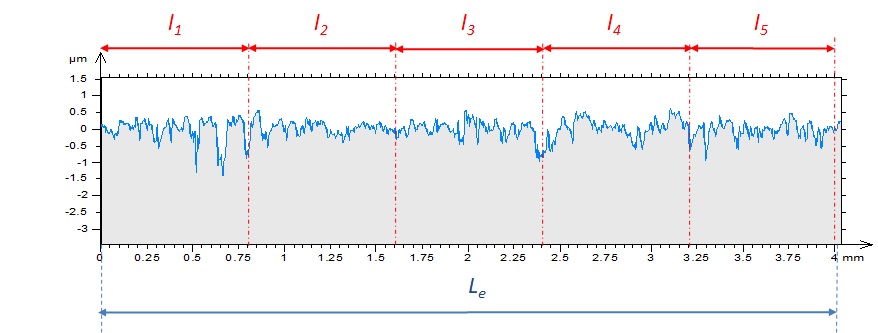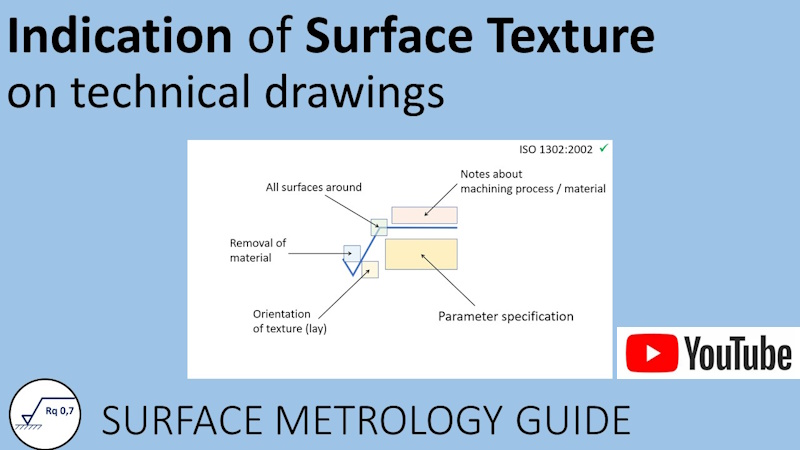The profile standards ISO 21920
The revision of all profile parameter standards is bound to change the way metrologists, technicians and engineers perform and analyze measurements. Here is an update of the main changes compared to previous standards.
1. Profilometry standards
Surface metrology is vastly dominated by profile measurements and profile parameters specifications. Many international standards related to profile specifications, measurements or analysis have been developed with the aim of guiding metrologists and designers:
ISO 1302 explains how to specify surface texture on drawings
ISO 4287 describes the main profile parameters (Ra, Wa and so on)
ISO 4288 explains how to apply parameters and select cut-offs
ISO 16610-21 describes the Gaussian profile filter
ISO 3274 describes the basic requirements for stylus profilometers
ISO 12179 explains how to calibrate a stylus profilometer
ISO 5436 describes the material measures used to calibrate instruments
ISO 12085 describes the motifs method and parameters (also called "French motifs"
ISO 13565 describes a robust filter and functional parameters used in the automotive industry
Most of these standards were published or last revised in the late 1990’s and have since been regularly confirmed without modification. However, the recent publication of ISO 25178 established a new universal basis for surface texture by initially targeting areal surface texture. It makes sense today to apply the same concepts to profile surface texture and therefore revise or replace existing standards.
ISO TC213 working group WG16 decided to unify existing profile standards in a three-part modern standard called ISO 21920.
2. A new standard in three parts
This project is organized into three parts, exactly as the first three parts of ISO 25178 which correspond to the first three columns of the GPS matrix (see ISO 14638):
1. Indication of profile surface texture on drawings
2. Terms, definitions and surface texture parameters
3. Specification operators
Example of roughness specification on a drawing.

Note the line segment above the triangle on the left of the radical sign, which identifies the specification as a profile surface texture specification.
The new profile standard is labelled ISO 21920 and is in three parts.
Part 1 of this new profile standard basically incorporates ISO 1302 with some additions coming from ISO 1101 and other specification documents.
Part 2 incorporates all parameters of existing profile standards and add new ones, either old parameters that have been dropped or ones adapted from ISO 25178; for example, Pvv provides the void volume of the valleys on the primary profile (adapted from Svv).
Part 3 gives default specifications that can be omitted on a drawing, such as units, nesting index, filter type, etc.
3. Changes to profile lengths
One of the main achievements of this draft is that parameters are now defined on the evaluation length. This means they are no longer calculated several times and then averaged. Instead, there will be only one Ra (or Rq) value calculated on the profile. The only exceptions are for Rp, Rv and Rz which will still be averaged to reduce the influence of outliers. Moreover the name sampling length is changed to section length to avoid confusion with the sampling of points on a discrete profile (see ISO 14406).

Averaging method as defined in ISO 4288. The above profile is divided into five sampling lengths (L1 to L5) on which five estimated values of a parameter are calculated and averaged. Some parameters are calculated on the evaluation length (Le) such as Rt. With ISO 21920, it is no longer the case and only one value is calculated over the evaluation length (with the exception of peak parameters).
Calculating parameters on the evaluation length is not new. ASME B46.1, the American standard for surface texture already specifies profile parameters without averaging the parameters on a number of sampling lengths.
Mountains® software already allows users to choose the profile length used to calculate parameters. (Go to File menu > Preferences (or F7) and Metrology > Filtering). The default setting is five sampling lengths but any number of sampling lengths can be defined. Alternatively, parameters can be calculated on all sampling lengths available on the profile or on the evaluation length.
4. Replacement of the 16% rule
Another important change concerns the 16% rule defined in ISO 4288, which is quite complex and not very well understood by users. The 16% rule is not the default rule anymore. The default rule is now the Max rule. The 16% rule may be replaced, if necessary, by specifying multiple measurements and setting a tolerance on a statistical parameter. Otherwise tolerances and specifications are verified with respect to a single measurement.
There are no plans to write documents describing instruments as they are already well specified in ISO 25178-60x for their metrological characteristics and ISO 25178-700 for their calibration. Furthermore, ISO 5436-1 is already incorporated into ISO 25178-70 which provides material measures for the calibration of surface texture instruments, areal or profile.
It is important to embrace the latest modifications brought by this new ISO 21920. Metrologists need to revise their procedures, designers need to adapt their specifications and instrument manufacturers need to update their analysis software.
5. What changes for Mountains®
Mountains® software, including MountainsMap® Profile, supports ISO 21920 parameters since version 8.1 but older standards are still supported.

6. Main modifications on profile parameters
All parameters are now defined on the evaluation length and are not averaged anymore (except the peak-to-valley parameters).
Height parameters
The definition of these parameters (Ra, Rq, Rsk, Rku, Rt) are unchanged. Some parameters, previously classified as height parameters (Rp, Rv) are now classified as peak-to-valley parameters (feature parameters).
Spatial parameters
Two parameters only are defined here: Ral, autocorrelation length, adapted from the areal parameter Sal; and Rsw, dominant spatial wavelength. The RSm parameter, formerly classified as a spatial parameter is now a feature parameter on elements.
Hybrid parameters
Rdq, root mean square gradient, is unchanged. But a new parameter, Rda, arithmetical mean gradient, is added (it was in ISO 4287 of 1984!) Not sure it will be confirmed in the published version. The new parameter, Rdt, gives the maximum absolute value of gradients. The new parameters, Rdl and Rdr, respectively give the developed length of the profile (in mm) and the developed length ratio (in %).
Material ratio parameters
Rmr and Rdc are unchanged. The new parameter, Rmc, is defined as the inverse of Rmr, as the areal parameter Smc was defined on surfaces.
Functional parameters, Rk
Parameters Rk, Rpk and Rvk are unchanged. New parameters, Rpkx and Rvkx are added, from the old DIN 4776 Rpk* and Rvk*. Parameters Rmr1 and Rmr2 are renamed Rmrk1 and Rmrk2, and Ra1 and Ra2 are renamed Rak1 and Rak2. Parameters Rpq, Rvq and Rmq from ISO 13565-3 are unchanged.
Volume parameters
Material volume and void volume parameters, from ISO 25178-2 are now available on profiles: Rvm, Rvmp, Rvmc, Rvv, Rvvc, Rvvv.
Fractal parameters
New parameters and functions are adapted from surfaces: Pvs, volume-scale; Puvs, upper volume-scale; Pls, length-scale, Psrc, smooth-rough crossover; Pvsfc, volume-scale complexity; Plsfc, length-scale complexity. These algorithms are available in the optional module Scale-Sensitive Fractal Analysis (SSFA) in Mountains®.
Peak-to-valley parameters
These parameters are based on point features (peaks and pits). Rp, Rv and Rz are unchanged, but are now calculated on section lengths instead of sampling lengths. New parameters are added: Rpt, maximum peak height; Rvt, maximum pit depths and Rzx, maximum height (which corresponds to the former Rmax parameter).
Parameters on elements
Rsm and Rc are unchanged but are now calculated with a robust algorithm (note the name Rsm instead of RSm). Standard deviations of these parameters are added: (Rsmq and Rcq) as well as the maximum value of element widths (Rsmx) and of element heights (Rcx). The pic count parameters, Rpc is calculated from Rsm, as in ISO 4287 Amendment 1.
Motifs parameters
Watershed segmentation is now available for profiles, in order to modernize the old R&W segmentation. New parameters, mainly adapted from ISO 25178-2, and defined: Rpd, density of peaks; Rmpc, mean curvature of peaks; R5p, mean height of the 5 highest peaks; R5v, mean depth of the 5 deepest pits; R10z, 10-point height. And also a series of parameters calculated on hills: Rhhm, Rhhq, Rhhx (mean, standard deviation, maximum) of their height; Rhwm, Rhwq, Rhwx of their width; Rhvm, Rhvq, Rhvx of their volume. And symmetrically on dales: Rddm, Rddq, Rddx, Rdwm, Rdwq, Rdwx, Rdvm, Rdvq, Rdvx.
Indication of surface texture on technical drawings
This video introduces the graphical language used to indicate surface texture specifications on technical drawings, according to ISO 1302. Changes introduced by the new ISO 21920-1 are also discussed.
Duration: 15 min 04 [Fully in English]
